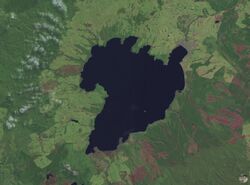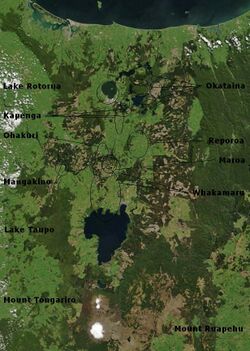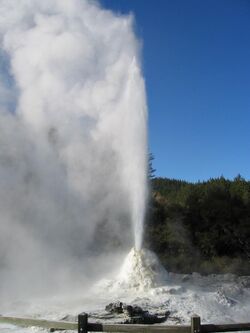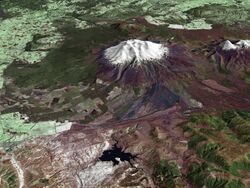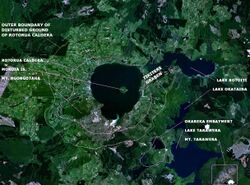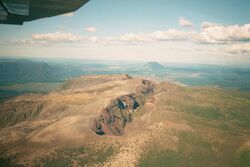Taupo Volcanic Zone
Topic: Earth
 From HandWiki - Reading time: 10 min
From HandWiki - Reading time: 10 min
The Taupō Volcanic Zone (TVZ) is a volcanic area in the North Island of New Zealand that has been active for the past two million years and is still highly active. Mount Ruapehu marks its south-western end and the zone runs north-eastward through the Taupo and Rotorua areas and offshore into the Bay of Plenty. It is part of the larger Central Volcanic Region that extends further westward through the western Bay of Plenty to the eastern side of the Coromandel Peninsula and has been active for four million years.[1] The Taupo Volcanic Zone is widening east–west at the rate of about 8 mm per year. It is named after Lake Taupo, the flooded caldera of the largest volcano in the zone, the Taupo Volcano.
Activity
There are numerous volcanic vents and geothermal fields in the zone, with Mount Ruapehu, Mount Ngauruhoe and White Island erupting most frequently.[2] The zone's largest eruption since the arrival of Europeans was that of Mount Tarawera in 1886, which killed over 100 people. Early Maori would also have been affected by the much larger Kaharoa eruption from Tarawera around 1300 AD.[3]
The last major eruption from Lake Taupō, the Hatepe eruption, occurred in 232 AD. It is believed to have first emptied the lake then followed that feat with a pyroclastic flow that covered about 20,000 km2 (7,700 sq mi) of land with volcanic ash. A total of 120 km3 (29 cu mi) of material is believed to have been ejected, and over 30 km3 (7.2 cu mi) of material is estimated to have been ejected in just a few minutes. The date of this activity was previously thought to be 186 AD as the ash expulsion was thought to be sufficiently large to turn the sky red over Rome and China (as documented in Hou Han Shu), but this has since been disproven.[citation needed]
Taupo erupted an estimated 1,170 km3 (280 cu mi) of material in its Oruanui eruption 26,500 years ago. This was Earth's most recent eruption reaching VEI-8, the highest level on the Volcanic Explosivity Index.
The Rotorua caldera has been dormant longer, with its main eruption occurring about 240,000 years ago, although lava dome extrusion has occurred within the last 25,000 years.[4]
Extent and geological context
The Taupo Volcanic zone is approximately 350 kilometres (217 mi) long by 50 kilometres (31 mi) wide. Mount Ruapehu marks its southwestern end, while White Island is considered its northeastern limit.[5]
It forms a southern portion of the active Lau-Havre-Taupo back-arc basin, which lies behind the Kermadec-Tonga subduction zone.[6][7] Volcanic activity continues to the north-northeast, along the line of the Taupo Volcanic Zone, through several undersea volcanoes (known as Clark, Tangaroa, the Silents and the Rumbles), then shifts eastward to the parallel volcanic arc of the Kermadec Islands and Tonga. Although the back-arc basin continues to propagate to the southwest, with the South Wanganui Basin forming an initial back-arc basin, volcanic activity has not yet begun in this region.[8]
South of Kaikoura the plate boundary changes to a transform boundary with oblique continental collision uplifting the Southern Alps / Kā Tiritiri o te Moana in the South Island. A subduction zone reappears southwest of Fiordland, at the southwestern corner of the South Island, although here the subduction is in the opposite direction. Solander Island is an extinct volcano associated with this subduction zone, and the only one that protrudes above the sea.
Scientific study
Recent scientific work indicates that the Earth's crust below the Taupo Volcanic Zone may be as little as 16 kilometres thick. A film of magma 50 kilometres (30 mi) wide and 160 kilometres (100 mi) long lies 10 kilometres under the surface.[9][10] The geological record indicates that some of the volcanoes in the area erupt infrequently but have large, violent and destructive eruptions when they do. There is also some possible rifting in the Taupo Volcanic Zone.
Volcanoes, lakes and geothermal fields
The following Volcanic Centers belong to the Taupo Volcanic Zone:
Rotorua, Okataina, Maroa, Taupo, Tongariro and Mangakino.[11][12]
- Whakatane Graben – Bay of Plenty
- Submarine Whakatane volcano [ ⚑ ] 36°48′S 177°30′E / 36.8°S 177.5°E
- Mayor Island/Tuhua [ ⚑ ] 37°17′S 176°15′E / 37.283°S 176.25°E
- Whale Island [ ⚑ ] 37°51′S 176°59′E / 37.85°S 176.983°E
- Whakaari/White Island [ ⚑ ] 37°31′S 177°11′E / 37.52°S 177.18°E
- Te Paepae o Aotea
- Mount Edgecumbe [ ⚑ ] 38°06′S 176°48′E / 38.1°S 176.8°E
- Geothermal field
- Kawerau Power Station [ ⚑ ] 38°03′47″S 176°43′38″E / 38.0631°S 176.7271°E
- Rotorua Volcanic Center
- Rotorua Caldera, size: 22 km wide [ ⚑ ] 38°05′S 176°16′E / 38.08°S 176.27°E[13]
- Ngongotahā (volcano)
- Lakes
- Geothermal fields
- Tikitere/Hell's Gate
- Whakarewarewa [ ⚑ ] 38°9′44″S 176°15′23″E / 38.16222°S 176.25639°E
- Pohutu Geyser
- Takeke
- Okataina Volcanic Center: The Haroharo and Tarawera complexes impounded the lakes against the outer margins of the Okataina Caldera. The Okareka Embayment and the Tarawera Volcanic Complex are inside the Haroharo Caldera which in turn is inside the Okataina Ring Structure, from Newhall (1988),[14] but newer maps show Okataina smaller.
- Okataina Caldera, size: roughly 27 x 20 km [ ⚑ ] 38°13′S 176°30′E / 38.22°S 176.5°E[15]
- Haroharo Caldera, size: 16 x 26 km[13]
- Haroharo volcanic complex, northern end of the Okataina Volcanic Center
- Mount Tarawera and Tarawera volcanic complex [ ⚑ ] 38°13′S 176°30′E / 38.22°S 176.5°E
- Okareka vent[16]
- Okareka Embayment
- Haroharo Caldera, size: 16 x 26 km[13]
- Rotoma Caldera[17]
- Lakes
- Lake Okataina [ ⚑ ] 38°07′S 176°25′E / 38.117°S 176.417°E
- Lake Tarawera [ ⚑ ] 38°12′S 176°27′E / 38.2°S 176.45°E
- Lake Rotokakahi (Green Lake) [ ⚑ ] 38°13′S 176°20′E / 38.217°S 176.333°E
- Lake Tikitapu (Blue Lake) [ ⚑ ] 38°12′S 176°20′E / 38.2°S 176.333°E
- Lake Okareka [ ⚑ ] 38°10′S 176°22′E / 38.167°S 176.367°E
- Lake Rotomahana [ ⚑ ] 38°16′S 176°27′E / 38.267°S 176.45°E
- Lake Rotoiti [ ⚑ ] 38°02′20″S 176°25′40″E / 38.0390°S 176.4277°E
- Lake Rotoma [ ⚑ ] 38°02′51″S 176°35′16″E / 38.0476°S 176.5878°E
- Lake Rotoehu [ ⚑ ] 38°1′S 176°32′E / 38.017°S 176.533°E
- Geothermal fields
- Waimangu Volcanic Rift Valley [ ⚑ ] 38°16′57″S 176°23′56″E / 38.2825°S 176.39889°E
- Frying Pan Lake
- Rotoma
- Waimangu Volcanic Rift Valley [ ⚑ ] 38°16′57″S 176°23′56″E / 38.2825°S 176.39889°E
- Okataina Caldera, size: roughly 27 x 20 km [ ⚑ ] 38°13′S 176°30′E / 38.22°S 176.5°E[15]
- Maroa Volcanic Center: The Maroa Caldera formed in the Northeast corner of the Whakamaru Caldera, the Whakamaru Caldera partially overlaps with the Taupo Caldera on the South. The Waikato River course follows roughly the northern Maroa caldera rim on one side. The town of Whakamaru and the artificial Lake Whakamaru, on the Waikato River, have the same name too.[13]
- Maroa Caldera, size: 16 x 25 km [ ⚑ ] 38°25′S 176°05′E / 38.42°S 176.08°E[13]
- Reporoa Caldera, size: 10 x 15 km [ ⚑ ] 38°25′S 176°20′E / 38.417°S 176.333°E[13]
- Whakamaru Caldera, size: 30 x 40 km[13]
- Geothermal fields
- Waiotapu [ ⚑ ] 38°21′34″S 176°22′11″E / 38.35944°S 176.36972°E
- Wairakei [ ⚑ ] 38°37′36″S 176°06′13″E / 38.626686°S 176.103491°E
- Craters of the Moon (Karapiti)
- Orakei Korako [ ⚑ ] 38°28′24″S 176°8′54″E / 38.47333°S 176.14833°E
- Ngatamariki
- Rotokaua
- Ohaaki Power Station [ ⚑ ] 38°31′37″S 176°17′31″E / 38.527°S 176.292°E
- Taupo Volcanic Center
- Taupo Caldera, size: roughly 35 km wide [ ⚑ ] 38°49′S 176°00′E / 38.82°S 176.00°E[13]
- Mount Tauhara
- Ben Lomond rhyolite dome (contains obsidian) [ ⚑ ] 38°35.7′S 175°57.2′E / 38.595°S 175.9533°E
- Lakes
- Lake Taupo [ ⚑ ] 38°49′S 176°00′E / 38.82°S 176.00°E
- Horomatangi Reefs
- Motutaiko Island
- Lake Taupo [ ⚑ ] 38°49′S 176°00′E / 38.82°S 176.00°E
- Geothermal fields
- Tauhara-Taupo
- Taupo Caldera, size: roughly 35 km wide [ ⚑ ] 38°49′S 176°00′E / 38.82°S 176.00°E[13]
- Tongariro Volcanic Center: Lake Taupo, Kakaramea, Pihanga, Tongariro and Ruapehu are roughly aligned on the main fault.
- Kakaramea
- Pihanga [ ⚑ ] 39°02′28.75″S 175°46′7″E / 39.0413194°S 175.76861°E
- Mount Tongariro and Tongariro volcanic complex [ ⚑ ] 39°8′S 175°39′E / 39.133°S 175.65°E
- Mount Ngauruhoe, a main Tongariro vent [ ⚑ ] 39°9′24.6″S 175°37′55.8″E / 39.156833°S 175.632167°E
- Tama crater lakes, main Tongariro vents
- Mount Ruapehu [ ⚑ ] 39°11′S 175°21′E / 39.18°S 175.35°E
- Hauhungatahi [ ⚑ ] 39°14′S 175°26′E / 39.23°S 175.44°E
- Lakes
- Lake Rotoaira [ ⚑ ] 39°03′16″S 175°42′51″E / 39.0545°S 175.7143°E
- Lake Rotopounamu [ ⚑ ] 39°01′36″S 175°44′18″E / 39.0267°S 175.7382°E
- Geothermal fields
- Ketetahi Springs
- Mangakino Volcanic Center: The Mangakino Volcanic Center is the westernmost and oldest rhyolitic caldera volcano in the Taupo Volcanic Zone.[18] The course of the Waikato River crosses this area, between the artificial Lake Ohakuri ( [ ⚑ ] 38°25′22″S 176°07′32″E / 38.42273°S 176.125474°E), the town of Mangakino ( [ ⚑ ] 38°23′S 175°47′E / 38.383°S 175.783°E) and Hamilton ( [ ⚑ ] 37°47′S 175°17′E / 37.783°S 175.283°E).
- Artificial Lake Maraetai
Other important features of the TVZ include the Whakatane, Ngakuru and Ruapehu grabens.
Note
There is nowadays a somewhat different classification:[19][20]
- North part: Whakatane Graben – Bay of Plenty
- Central part:
- West of the main fault zone:
- Mangakino caldera complex; may be transitional between Coromandel Volcanic Zone (CVZ) and Taupo Volcanic Zone (TVZ) (1.62 – 0.91 mio. years old)
- Kapenga caldera; lies between the Maroa caldera and the Rotorua caldera, it is completely buried under more recent tephra (circa 700,000 years old)
- Okareka Embayment, lies inside the northern end of the Kapenga Caldera, between the Tarawera volcanic complex and the Lake Rotorua[17]
- Rotorua single event caldera; Mamaku Ignimbrite (circa 240,000 years old)
- Main fault zone:
- Okataina caldera complex
- Haroharo caldera complex
- Tarawera volcanic complex
- Okareka Embayment
- Haroharo caldera complex
- Whakamaru caldera complex
- Maroa caldera
- Ohakuri single event caldera; Ohakuri Ignimbrite; lies West of the Ohakuri Dam, the Waikato River course follows roughly the southern caldera rim on one side (circa 240,000 years old).[21]
- Taupo caldera complex
- Okataina caldera complex
- East of the main fault zone:
- Reporoa single event caldera; Kaingaroa Ignimbrite (circa 240,000 years old)
- West of the main fault zone:
- South part: Tongariro Volcanic Centre
See also
References
- ↑ Cole, J.W.; Darby, D.J.; Stern, T.A. (1995). "Taupo Volcanic Zone and Central Volcanic Region: Backarc Structures of North Island, New Zealand". in Taylor, Brian. Backarc Basins: Tectonics and Magmatism. New York: Plenum. p. 3. ISBN 978-1-4615-1843-3.
- ↑ Waight, Tod E.; Troll, Valentin R.; Gamble, John A.; Price, Richard C.; Chadwick, Jane P. (2017-07-01). "Hf isotope evidence for variable slab input and crustal addition in basalts and andesites of the Taupo Volcanic Zone, New Zealand" (in en). Lithos 284-285: 222–236. doi:10.1016/j.lithos.2017.04.009. ISSN 0024-4937. Bibcode: 2017Litho.284..222W. http://www.sciencedirect.com/science/article/pii/S0024493717301470.
- ↑ David, Lowe. "Polynesian settlement and impacts of volcanism on early Maori society". in Lowe, D.J.. Guidebook for 'Land and Lakes' field trip, New Zealand Society of Soil Science Biennial Conference, Rotorua, held in 27–30 November 2006. Lincoln: New Zealand Society of Soil Science. pp. 50–55. http://earth.waikato.ac.nz/staff/lowe/download/Rotorua_Land_and_Lakes_field_trip_NZSSS-1_Dec_06-web.pdf.
- ↑ "Rotorua". Smithsonian Institution. https://volcano.si.edu/volcano.cfm?vn=241816.
- ↑ Gamble, J. A.; Wright, I. C.; Baker, J. A. (1993). "Seafloor geology and petrology in the oceanic to continental transition zone of the Kermadec-Havre-Taupo Volcanic Zone arc system, New Zealand". New Zealand Journal of Geology and Geophysics 36 (4): 417–435. doi:10.1080/00288306.1993.9514588. Archived from the original on 2008-11-22. https://web.archive.org/web/20081122075312/http://www.rsnz.org/publish/nzjgg/1993/40.php.
- ↑ Caratori Tontini, F.; Bassett, D.; de Ronde, C. E. J.; Timm, C.; Wysoczanski, R. (2019). "Early evolution of a young back-arc basin in the Havre Trough". Nature Geoscience 12 (10): 856–862. doi:10.1038/s41561-019-0439-y. Bibcode: 2019NatGe..12..856C. http://oceanrep.geomar.de/47797/13/pm_2019_44_plattenbewegung-NZ.pdf.
- ↑ Parson, L. M.; Wright, I. C. (1996). "The Lau-Havre-Taupo back-arc basin: A southward-propagating, multi-stage evolution from rifting to spreading". Tectonophysics 263 (1–4): 1–22. doi:10.1016/S0040-1951(96)00029-7. Bibcode: 1996Tectp.263....1P.
- ↑ Villamor, P.; Berryman, K. R. (2006). "Evolution of the southern termination of the Taupo Rift, New Zealand". New Zealand Journal of Geology and Geophysics 49: 23–37. doi:10.1080/00288306.2006.9515145.
- ↑ Easton, Paul (15 September 2007). "Central North Island sitting on magma film". The Dominion Post. http://www.stuff.co.nz/4202557a11.html. Retrieved 16 March 2008.
- ↑ Heise, W.; Bibby, H.M.; Caldwell, T.G. (2007). "Imaging magmatic Processes in the Taupo Volcanic Zone (New Zealand) with Magnetotellurics". Geophysical Research Abstracts 9. http://www.cosis.net/abstracts/EGU2007/01311/EGU2007-J-01311.pdf?PHPSESSID=e. 01311.
- ↑ Cole, J.W. (1990). "Structural control and origin of volcanism in the Taupo volcanic zone, New Zealand". Bulletin of Volcanology 52 (6): 445–459. doi:10.1007/BF00268925. Bibcode: 1990BVol...52..445C.
- ↑ "New Zealand". http://volcano.oregonstate.edu/vwdocs/volc_images/australia/new_zealand/.
- ↑ 13.0 13.1 13.2 13.3 13.4 13.5 13.6 http://www.volcano.si.edu/world/largeeruptions.cfm
- ↑ Newhall, Christopher G.; Dzurisin, Daniel (1988). "Historical unrest at large calderas of the world". USGS Bulletin 1855: 1108. https://pubs.er.usgs.gov/usgspubs/b/b1855. Citing Scott, B.J. (1986). Gregory, J.G.; Watters, W.A.. eds. "Volcanic hazards assessment in New Zealand: Monitoring at Okataina Volcanic Centre". New Zealand Geol. Surv. Rec. 10: 49–54.
- ↑ Okataina Volcanic Center, New Zealand
- ↑ Nairn, I.A. (2002). Geology of the Okatania Volcanic Centre. Geological Map 25. Institute of Geological and Nuclear Sciences. pp. 156.
- ↑ 17.0 17.1 Hodgson, K. A.; Nairn, I. A. (August 2004). "The Sedimentation and Drainage History of Haroharo Caldera and The Tarawera River System, Taupo Volcanic Zone, New Zealand". Operations Publication 2004/03 (Environment Bay of Plenty): 7. ISSN 1176-5550. http://www.envbop.govt.nz/Reports/Report-0408-TheSedimentationAndDrainageHistoryOfHaroharoCalderaAndTheTaraweraRiverSystemTaupoVolcanicZoneNewZealand.pdf.
- ↑ Krippner, Stephen J. P.; Briggs, Roger M.; Wilson, Colin J. N.; Cole, James W. (1998). "Petrography and geochemistry of lithic fragments in ignimbrites from the Mangakino Volcanic Centre: implications for the composition of the subvolcanic crust in western Taupo Volcanic Zone, New Zealand". New Zealand Journal of Geology and Geophysics 41 (2): 187–199. doi:10.1080/00288306.1998.9514803.
- ↑ Cole, J. W.; Spinks, K. D. (2009). "Caldera volcanism and rift structure in the Taupo Volcanic Zone, New Zealand". Special Publications (London: Geological Society) 327 (1): 9–29. doi:10.1144/SP327.2. Bibcode: 2009GSLSP.327....9C. http://sp.lyellcollection.org/cgi/content/abstract/327/1/9.
- ↑ Hiess, J; Cole, JW; Spinks, KD (2007). High-Alumina Basalts of the Taupo Volcanic Zone, New Zealand: Influence of the Crust and Crustal Structure. pp. 36. http://ir.canterbury.ac.nz/bitstream/10092/3172/1/12605971_Hiess%20%202007%20final.pdf. Part of a BSc Project by Hiess, J. (University of Canterbury).
- ↑ Gravley, D. M.; Wilson, C. J. N.; Rosenberg, M. D.; Leonard, G. S. (2006). "The nature and age of Ohakuri Formation and Ohakuri Group rocks in surface exposures and geothermal drillhole sequences in the central Taupo Volcanic Zone, New Zealand". New Zealand Journal of Geology and Geophysics 49 (3): 305–308. doi:10.1080/00288306.2006.9515169. http://www.royalsociety.org.nz/publications/journals/nzjg/2006/026/.
External links
- Further information on Taupo volcanics
- Tectonic plate information
- Earthquake risks
- New Zealand's volcanoes: The Taupo Volcanic Centre
- New Zealand's volcanoes: The Okataina Volcanic Centre
- Environment Bay of Plenty, Regional Council, Library
- Maps
- Environment Waikato, Regional Council, map
- Lowe, D.J., ed. Guidebook for 'Land and Lakes' field trip, New Zealand Society of Soil Science Biennial Conference, Rotorua, held in 27–30 November 2006. Lincoln: New Zealand Society of Soil Science. pp. 63. http://earth.waikato.ac.nz/staff/lowe/download/Rotorua_Land_and_Lakes_field_trip_NZSSS-1_Dec_06-web.pdf.
- Hiess, J; Cole, JW; Spinks, KD (2007). High-Alumina Basalts of the Taupo Volcanic Zone, New Zealand: Influence of the Crust and Crustal Structure. pp. 36. http://ir.canterbury.ac.nz/bitstream/10092/3172/1/12605971_Hiess%20%202007%20final.pdf. Part of a BSc Project by Hiess, J. (University of Canterbury). Map modified from: Spinks, Karl D; Acocella, Valerio; Cole, Jim W; Bassett, Kari N (15 June 2005). "Structural control of volcanism and caldera development in the transtensional Taupo Volcanic Zone, New Zealand". Journal of Volcanology and Geothermal Research 144 (1–4): 7–22. doi:10.1016/j.jvolgeores.2004.11.014. Bibcode: 2005JVGR..144....7S.
- Geological Society of New Zealand & New Zealand Geophysical Society - Fieldtrip 2
- Houghton, Bruce F. (2007). Field Guide - Taupo Volcanic Zone. http://www2.hawaii.edu/~bhoughto/NZ_Field_Guide_Spring07.pdf.
- New Zealand, Taupo and Coromandel volcanic zones
- Newhall, Christopher G.; Dzurisin, Daniel (1988). "Historical unrest at large calderas of the world". USGS Bulletin 1855: 1108. https://pubs.er.usgs.gov/usgspubs/b/b1855.
- The Taupo Volcanic Zone with Māori Freehold Land (1995) - showing geothermal fields
 KSF
KSF
